
© Paul B. Goode. (Click image for larger version)
Paul Taylor Dance Company
Spring Season Review: American Dreamer, Banquet of Vultures, Black Tuesday, Byzantium, Cloven Kingdom, Dante Variations, A Field of Grass, Gossamer Gallants, Perpetual Dawn
New York, David H. Koch
22, 23, 26, and 29 March (all matinées) 2014
www.ptdc.org
www.davidhkochtheater.com
Season of Taylor
Today (March 30) the Paul Taylor Dance Company’s sixtieth New York season – its third at Lincoln Center – draws to a close. It’s also the company’s final New York appearance as a purely Taylor-centered enterprise. As of next year, it will transform itself into a mixed repertory troupe, performing the works of other modern-dance-makers alongside those of Taylor. This is a major transformation, and one that is not easy to envision at this point. Which choreographers will be represented? How will the works be chosen? How will they look on these particular dancers, so practiced in the fluidly athletic, muscular style Taylor has honed over many decades? How will his dancers feel about the change?
One aspect of the transformation, however, is unquestionably cause for celebration: the plan to include “live music accompaniment where intended by the choreographer,” as the company announced earlier in the season. The use of recordings has been a real problem in recent seasons at the Koch. Not that there was live music before, but its absence is more noticeable here, in the home of New York City Ballet, with its large pit, which lies empty and dark. In addition to which, the sound system at the Koch is truly horrible. Treble notes are uncomfortably shrill, voices are blurry, and often the music is simply too muffled and too soft to support the choreography, as in a recent performance of Black Tuesday (March 29). The dancers seemed to be moving in a vacuum. They, and the choreography, deserve better.

© Paul B. Goode. (Click image for larger version)
Taylor’s dancers continue to move with their particular combination of generosity and tirelessness. They come in different sizes and types, like the rest of us, though it is still very much predominantly a white company – I wonder why this is? Each dancer has his or her own quality: Michael Novak, a relative newcomer, dances with joy and openness, as if grateful to be among friends. James Samson, one of the senior members, embodies a bygone all-American wholesomeness. He’s like a figure from a Saturday Evening Post cover. Michelle Fleet is light, crisp, fast, sweet. Sean Mahoney is big, sweaty, by turns menacing and funny. Heather McGinley is all elegance and purity of line; Eran Bugge, femininity and sensuality. I could go on. The season’s standout was Christina Lynch Markham, a longtime member of Paul Taylor 2 who was just recently recruited into the main troupe. Taylor seems to have taken a special interest, featuring her in Cloven Kingdom, Dante Variations, and Byzantium, among others; in return she danced with ferocious attack, pushing herself to a physical extreme with every contraction, twist, and fall.
What other modern-dance company can present a three-week-season of twenty-three works by its founding choreographer? Among these are great dances that one can see again and again without losing interest, like Cloven Kingdom, Esplanade and Sunset. But – and this is hardly news – there are quite a few that don’t rise to this level. It’s hard to compete against yourself, especially when your best is an American classic, like Esplanade. I wonder what a first-timer might have made of the program I saw at the March 26 matinée, for example, which opened with A Field of Grass, went on to Banquet of Vultures, and ended with Cloven Kingdom. Two mediocrities and one major – and completely original – work of modern dance.
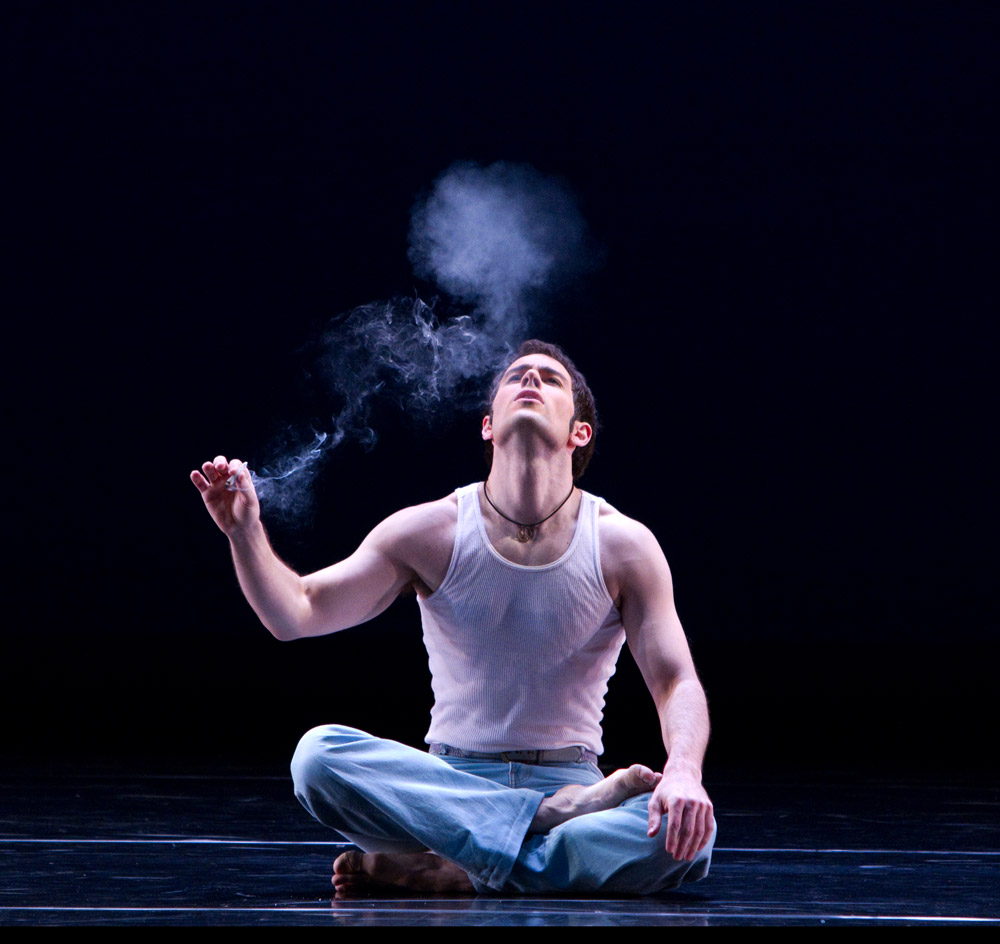
© Paul B. Goode. (Click image for larger version)
A Field of Grass is a half-hearted 1960’s reverie, full of recycled Taylor moves – somersaults and sissonnes and skittering steps with one arm held out, as if running for the bus – and unconvincing clichés about drugs and hippie culture, set to Nilsson songs. It’s empty and phony and there’s nothing the dancers can do to save it, despite their charm and straightforward delivery. Banquet of Vultures, in turn, is a rather literal-minded reaction to the Iraq war, with a blue-suited despot – modeled after George W. Bush I suppose – marching robotically and striking down everyone in his path. But, unlike A Fields of Grass, Banquet contains an extraordinary moment, a pas de deux whose nastiness rivals that of Big Bertha. The blue-suited figure torments, brutalizes and kills a defenseless woman. (I don’t know how Jamie Rae Walker can walk after being thrown around and dropped on the floor with such brutality.) But despite this moment of intensity, the work is short on ideas. As a meditation on war, it doesn’t come anywhere near the pathos and specificity of Company B.
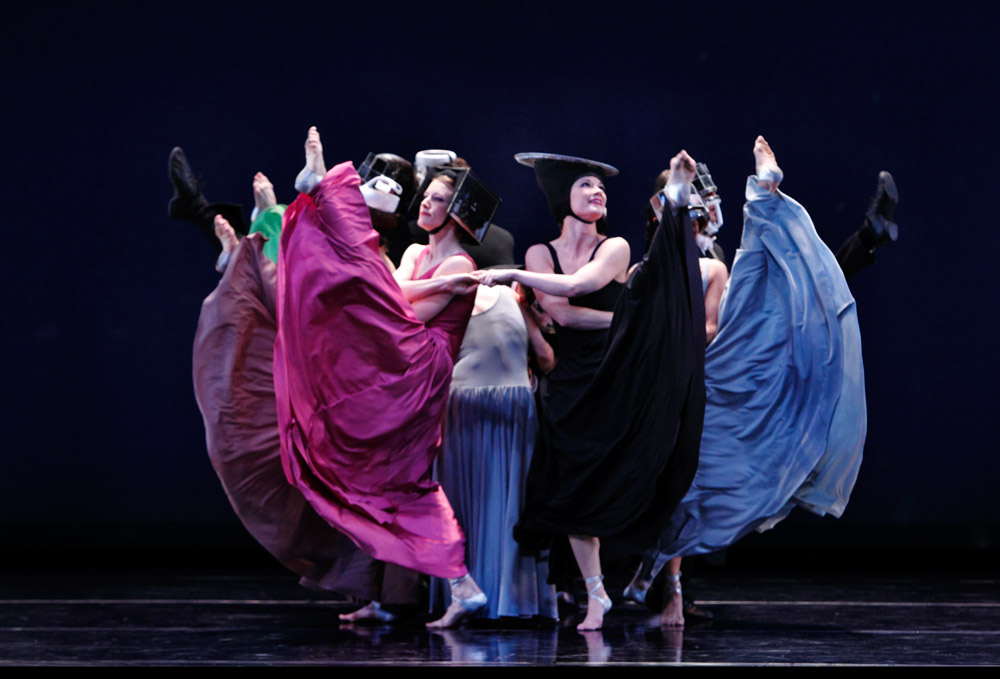
© Paul B. Goode. (Click image for larger version)
Cloven Kingdom always reminds me of Taylor’s autobiography, Private Domain, in which he describes how, as a kid, he used to sit and watch an ant colony for hours. Here, the people are the ants. Taylor peels away the layers of civility, uncovering the ugly, nasty nature of apparently well-mannered people. Wearing morning coats and flattering gowns, the characters are like guests at a coming-out ball, preening and ceremonious. But strange things start to happen. The refined Baroque melodies are interrupted by ominous bursts of percussion. A woman careens across the stage wearing a giant silver balloon on her head. Two woman enact a slow, stately pas de deux wearing mirrored headdresses, blinding the audience with shards of reflected light. At first they treat each other with formality, but soon enough one of them is straddling the other. The victim cowers at her tormentor’s feet. Slowly they crawl offstage, locked in their private drama. Four men then enter and perform the dance’s most famous section, a kind of male initiation with sexual overtones. They clamber and roll over each other, stomp, launch themselves into competitive jumps, crawl between each other’s legs – it’s a frat-party gone wild. But then the light changes and the two women return, in the same pose as before. The transition never fails to surprise. Cloven Kingdom leaves you with an acrid taste in your mouth, and images that linger in the brain.
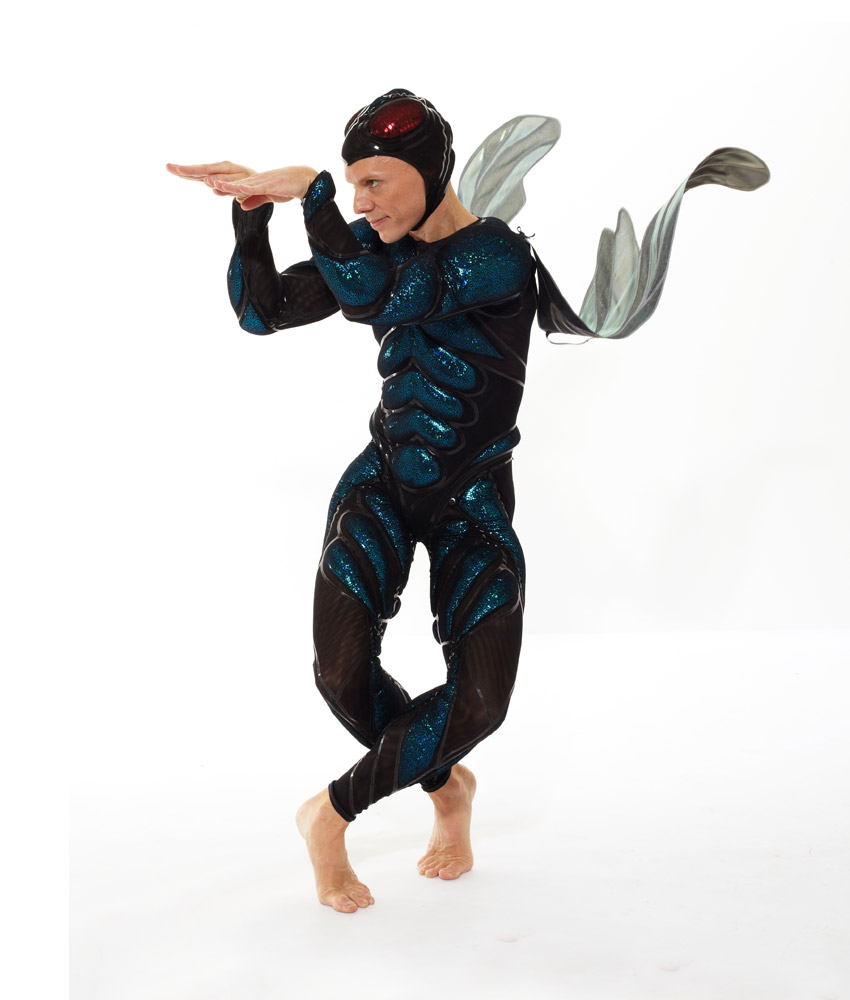
© Tom Caravaglia. (Click image for larger version)
The March 29 matinée contained one great piece – Black Tuesday – followed by a frolicsome pastoral – Perpetual Dawn – danced to the accompaniment of generic Baroque concerti grossi, and an irksome farce about the mating rituals of fireflies – Gossamer Gallants. The latter is accompanied by the lively dance music from Smetana’s Bartered Bride, but the recording seems to have been chosen mainly for its brisk tempi. Perpetual Dawn displays one of Taylor’s signature styles: buoyant, lyrical, upbeat with touches of sadness, but it lacks the gravitas or grandeur of a work like Esplanade. The light-hearted music chugs along as the dancers run, leap, and cuddle, smiling all the while. It’s a celebration of anodyne love. It pales even further when paired with Black Tuesday, one of Taylor’s most compelling period pieces, set to popular songs from the Great Depression.
Black Tuesday is a portrait of a world Taylor knows through the experience of his parents: the America of the thirties. It is bitter and cynical, but also a tiny bit hopeful. It’s also rife with references to old movies. The street urchin who dances the sharp, tart “I Went Hunting and the Big Bad Wolf Was Dead” is like the flip side of Chaplin’s Kid. (Hats off to Jamie Rae Walker for her spitfire interpretation.) “Slumming on Park Avenue,” a vaudevillian duet for two urban hobos, bears more than a glancing resemblance to the Fred Astaire-Judy Garland duo “We’ll Walk up the Avenue” in Easter Parade. And the lady of the night who dances the heart-rending “Boulevard of Broken Dreams,” cast spread-eagled from man to man and left in a heap to die is a character straight out of a Hollywood melodrama. The role was created for the former company member Annmaria Mazzini, whose dancing has a particularly raw, full-bodied quality. Because the dancer performing the role was injured, at the March 29 matinée Mazzini was invited to give it another whirl. (A real gesture of affection for a much-loved former colleague.) As one might expect, she gave a burning performance. Once a Taylor dancer, always a Taylor dancer.
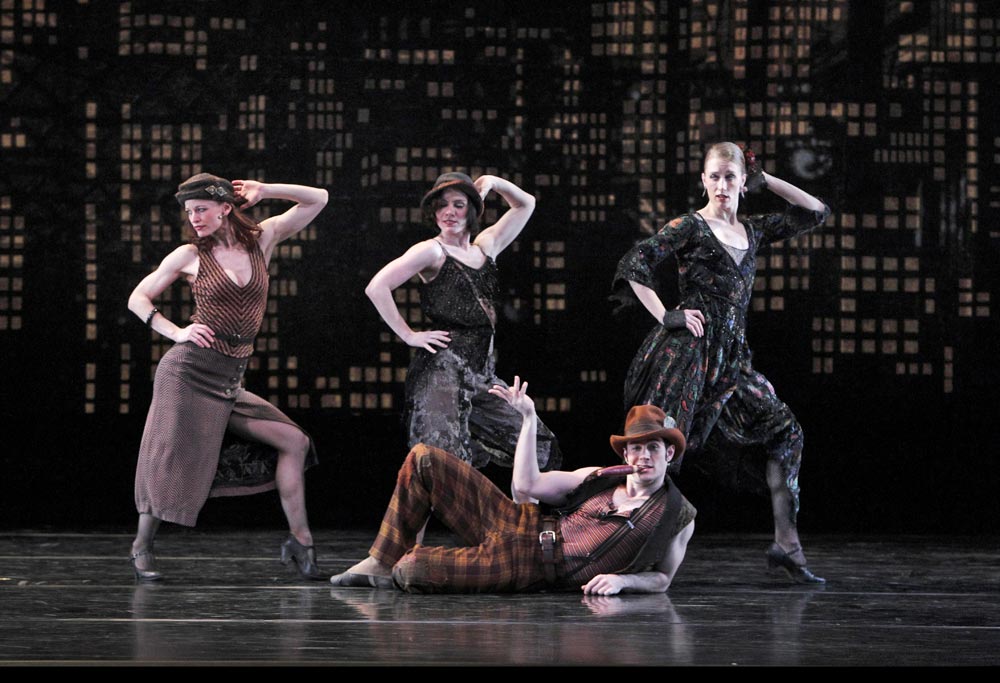
© Paul B. Goode. (Click image for larger version)
Other highlights of the season included “Dante Variations” and “Byzantium,” both surreal, nightmarish visions. “Byzantium” is Taylor at his most theatrical. In its middle section, “Past,” four priestly figures in golden robes strike impassive, mysterious poses, communicating impenetrable messages with their fingers and hands. Are they meant to represent the truth or merely the repressive power of religion? All around we see an array of lascivious behavior until finally, two “sinners” are mercilessly punished. Divine law triumphs. The more recent “Dante Variations” uses Gyorgi Ligeti’s Musica Ricercata – the same music Wheeldon used in his Polyphonia, transcribed here for barrel organ – as a backdrop for various depictions of man’s fate in the afterlife. Sean Mahoney dances with a piece of toilet paper stuck to his foot, another tries to move with his legs bound, or with his arms strapped behind his back. Thus, humanity is reduced to its most ridiculous, pitiful state. But what really grabs our attention is a creepy passage in which a woman (Eran Bugge) dances for her own pleasure, under the malevolent gaze of a voyeur (Michael Trusnovec) lurking in the shadows. He looks like he is about to devour her. Taylor’s capacity for creepiness is unparalleled.
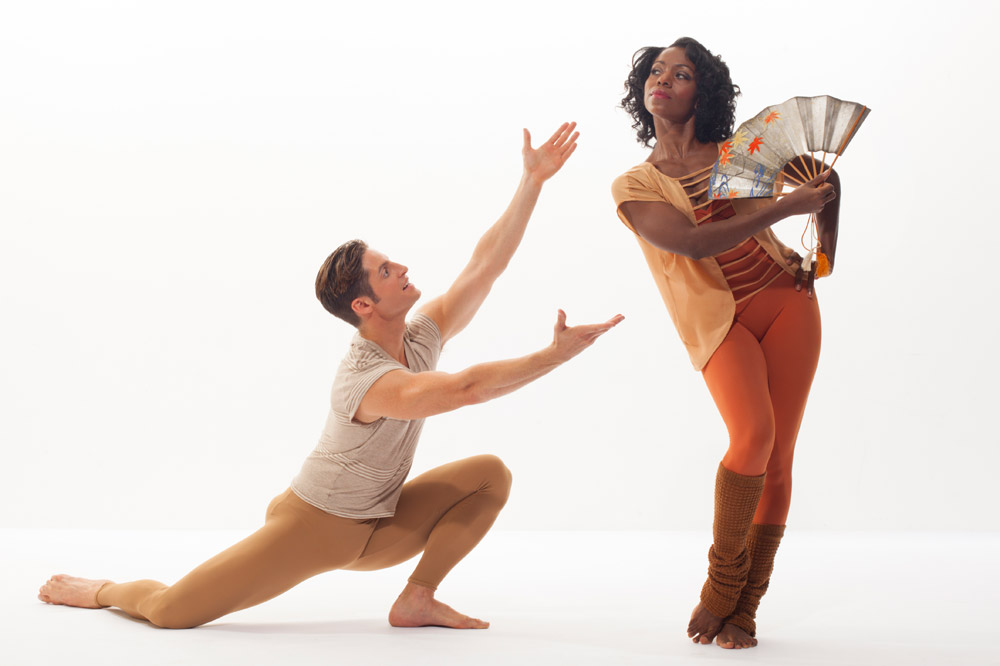
© Tom Caravaglia. (Click image for larger version)
I only caught one of two new works presented this season. American Dreamer is a nostalgic little dance set to Thomas Hampson’s mellifluous recording of familiar Stephen Forster songs like “Beautiful Dreamer.” It has a backstage feel; there’s a barre upstage, and a trunk, from which dancers select hats, bits of fabric. In “My Wife is a Most Knowing Woman,” a series of women abuse their husbands. In “Linger in Blissful Repose,” a man awakens each of three fair sleeping maidens only to have her sleepwalk past him without a thought. The piece is short and rather slight, but it feels like a love letter from Taylor to his dancers, a hat-tip to a life in the theatre. I hope it’s not a farewell.












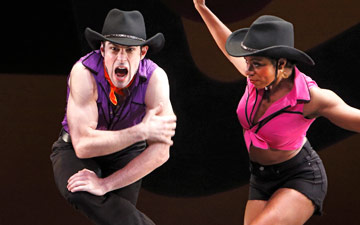

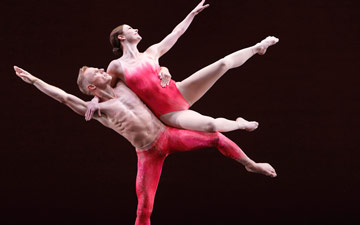
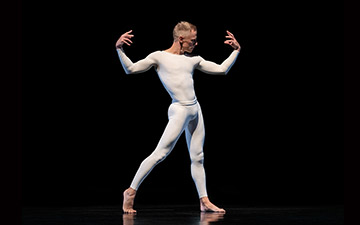
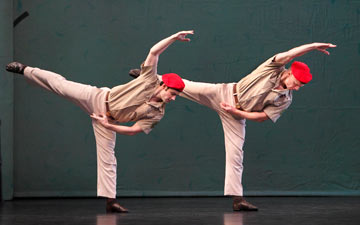
You must be logged in to post a comment.